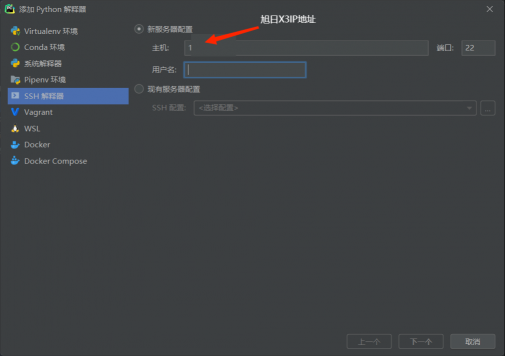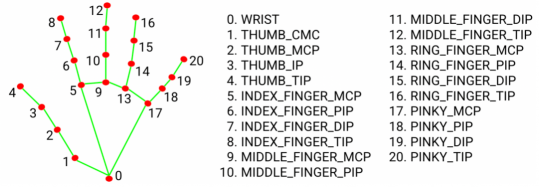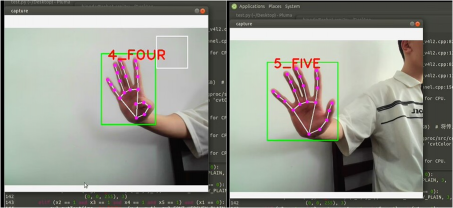作者阿#杰
本篇博客通過旭日X3搭載手勢識別算法,實現實時檢測,同時測試其運行性能。
針對旭日X3上并沒有很好的python IDE編譯環境的問題,本篇博客通過SSH遠程連接的方式,可以在不給旭日X3內存壓力的同時, 提供一個更好的代碼編寫環境, 同時通過SSH的方式給旭日X3配置對應的環境 ,起到方便快捷的作用。
一、準備工作
首先在電腦上安裝配有pycharm專業版(專業版可以使用ssh遠程登陸,學生使用教育郵箱申請pycharm專業版)。
Pycharm是一款用于Python編程的集成開發環境(IDE)。它可以幫助您編寫,測試和調試代碼,并具有諸如代碼提示,自動完成和錯誤檢測等功能,以幫助您更快地編寫高質量的代碼。
本次主要使用通過SSH遠程連接旭日X3,以便于傳輸代碼到x3派上,實現python的遠程操作。

其次,本次工作用到Meidapipe功能包,MediaPipe 是一款由 Google Research 開發并開源的多媒體機器學習模型應用框架,可以直接調用其API完成目標檢測、人臉檢測以及關鍵點檢測等。
Meidapipe是一個針對深度學習模型的高效執行庫,由PyTorch設計而成,提供了高級API,用于加速預測和推理的過程。它為模型執行提供了優化和并行化的功能,并且支持多個GPU和分布式訓練。
同時,Meidapipe還支持模型壓縮和部署,使模型在嵌入式設備和移動設備上的執行更加高效和靈活。

項目完成的效果展示:

二、部署過程
在x3派上安裝pip3及導入Meidapipe包:
sudo apt install python3-pip pip3 install mediapipe -i https://mirrors.cloud.tencent.com/pypi/simple
確定旭日X3中攝像頭端口:
首先不插usb攝像頭輸入
ls /dev/video*
然后插上usb攝像頭再輸入ls /dev/video*
多出的端口號即為攝像頭端口。
創建手部類對象
初始化手部對象
hands是檢測手部關鍵點的函數,其中有4個輸入參數量可以選擇
1、static_image_mode:默認為False,如果設置為false, 就是把輸入看作一個視頻流,在檢測到手之后對手加了一個目標跟蹤(目標檢測+跟蹤),無需調用另一次檢測,直到失去對任何手的跟蹤為止。
如果設置為True,則手部檢測將在每個輸入圖像上運行(目標檢測),非常適合處理一批靜態的,可能不相關的圖像。(如果檢測的是圖片就要設置成True)
2、max_num_hands:可以檢測到的手的數量最大值,默認是2
3、min_detection_confidence: 手部檢測的最小置信度值,大于這個數值被認為是成功的檢測。默認為0.5
4、min_tracking_confidence:目標蹤模型的最小置信度值,大于這個數值將被視為已成功跟蹤的手部,默認為0.5,如果static_image_mode設置為true,則忽略此操作。
class HandDetector: """ 使用mediapipe庫查找手。導出地標像素格式。添加了額外的功能。 如查找方式,許多手指向上或兩個手指之間的距離。而且提供找到的手的邊界框信息。 """ def __init__(self, mode=False, maxHands=2, detectionCon=0.5, minTrackCon=0.5): """ :param mode: 在靜態模式下,對每個圖像進行檢測 :param maxHands: 要檢測的最大手數 :param detectionCon: 最小檢測置信度 :param minTrackCon: 最小跟蹤置信度 """ self.mode = mode self.maxHands = maxHands self.modelComplex = False self.detectionCon = detectionCon self.minTrackCon = minTrackCon # 初始化手部識別模型 self.mpHands = mp.solutions.hands self.hands = self.mpHands.Hands(self.mode, self.maxHands, self.modelComplex, self.detectionCon, self.minTrackCon) self.mpDraw = mp.solutions.drawing_utils # 初始化繪圖器 self.tipIds = [4, 8, 12, 16, 20] # 指尖列表 self.fingers = [] self.lmList = []
創建發現手部并在圖像中繪制函數,返回繪制后的圖像。
def findHands(self, img, draw=True): """ 從圖像(BRG)中找到手部。 :param img: 用于查找手的圖像。 :param draw: 在圖像上繪制輸出的標志。 :return: 帶或不帶圖形的圖像 """ imgRGB = cv2.cvtColor(img, cv2.COLOR_BGR2RGB) # 將傳入的圖像由BGR模式轉標準的Opencv模式——RGB模式, self.results = self.hands.process(imgRGB) if self.results.multi_hand_landmarks: for handLms in self.results.multi_hand_landmarks: if draw: self.mpDraw.draw_landmarks(img, handLms, self.mpHands.HAND_CONNECTIONS) return img
創建發現手部坐標函數,并返回手部坐標列表。
def findPosition(self, img, handNo=0, draw=True):
"""
查找單手的地標并將其放入列表中像素格式。還可以返回手部周圍的邊界框。
:param img: 要查找的主圖像
:param handNo: 如果檢測到多只手,則為手部id
:param draw: 在圖像上繪制輸出的標志。(默認繪制矩形框)
:return: 像素格式的手部關節位置列表;手部邊界框
"""
xList = []
yList = []
bbox = []
bboxInfo = []
self.lmList = []
if self.results.multi_hand_landmarks:
myHand = self.results.multi_hand_landmarks[handNo]
for id, lm in enumerate(myHand.landmark):
h, w, c = img.shape
px, py = int(lm.x * w), int(lm.y * h)
xList.append(px)
yList.append(py)
self.lmList.append([px, py])
if draw:
cv2.circle(img, (px, py), 5, (255, 0, 255), cv2.FILLED)
xmin, xmax = min(xList), max(xList)
ymin, ymax = min(yList), max(yList)
boxW, boxH = xmax - xmin, ymax - ymin
bbox = xmin, ymin, boxW, boxH
cx, cy = bbox[0] + (bbox[2] // 2),
bbox[1] + (bbox[3] // 2)
bboxInfo = {"id": id, "bbox": bbox, "center": (cx, cy)}
if draw:
cv2.rectangle(img, (bbox[0] - 20, bbox[1] - 20),
(bbox[0] + bbox[2] + 20, bbox[1] + bbox[3] + 20),
(0, 255, 0), 2)
return self.lmList, bboxInfo
判斷展開手指數量,同時區分左右手。
def fingersUp(self):
"""
查找列表中打開并返回的手指數。會分別考慮左手和右手
:return:豎起手指的列表
"""
if self.results.multi_hand_landmarks:
myHandType = self.handType()
fingers = []
# Thumb
if myHandType == "Right":
if self.lmList[self.tipIds[0]][0] > self.lmList[self.tipIds[0] - 1][0]:
fingers.append(1)
else:
fingers.append(0)
else:
if self.lmList[self.tipIds[0]][0] < self.lmList[self.tipIds[0] - 1][0]:
? ? ? ? ? ? ? ?fingers.append(1)
? ? ? ? ? ?else:
? ? ? ? ? ? ? ?fingers.append(0)
? ? ? ?# 4 Fingers
? ? ? ?for id in range(1, 5):
? ? ? ? ? ?if self.lmList[self.tipIds[id]][1] < self.lmList[self.tipIds[id] - 2][1]:
? ? ? ? ? ? ? ?fingers.append(1)
? ? ? ? ? ?else:
? ? ? ? ? ? ? ?fingers.append(0)
? ?return fingers
判斷識別到的是左手 or 右手。
def handType(self):
"""
檢查傳入的手部是左還是右
:return: "Right" 或 "Left"
"""
if self.results.multi_hand_landmarks:
if self.lmList[17][0] < self.lmList[5][0]:
? ? ? ? ? ?return "Right"
? ? ? ?else:
? ? ? ? ? ?return "Left"
以上為手部檢測類中方法的創建實現,通過調用類的方式來實現相應的功能。
創建Main類,用于具體實現功能
攝像頭初始化
class Main:
def __init__(self):
self.camera = cv2.VideoCapture(1, cv2.CAP_DSHOW)
self.camera.set(3, 1280)
self.camera.set(4, 720)
調用手部類,并將相關信息顯示在實時畫面中
def Gesture_recognition(self):
while True:
self.detector = HandDetector()
frame, img = self.camera.read()
img = self.detector.findHands(img)
lmList, bbox = self.detector.findPosition(img)
if lmList:
x_1, y_1 = bbox["bbox"][0], bbox["bbox"][1]
x1, x2, x3, x4, x5 = self.detector.fingersUp()
if (x2 == 1 and x3 == 1) and (x4 == 0 and x5 == 0 and x1 == 0):
cv2.putText(img, "2_TWO", (x_1, y_1), cv2.FONT_HERSHEY_PLAIN, 3,
(0, 0, 255), 3)
elif (x2 == 1 and x3 == 1 and x4 == 1) and (x1 == 0 and x5 == 0):
cv2.putText(img, "3_THREE", (x_1, y_1), cv2.FONT_HERSHEY_PLAIN, 3,
(0, 0, 255), 3)
elif (x2 == 1 and x3 == 1 and x4 == 1 and x5 == 1) and (x1 == 0):
cv2.putText(img, "4_FOUR", (x_1, y_1), cv2.FONT_HERSHEY_PLAIN, 3,
(0, 0, 255), 3)
elif x1 == 1 and x2 == 1 and x3 == 1 and x4 == 1 and x5 == 1:
cv2.putText(img, "5_FIVE", (x_1, y_1), cv2.FONT_HERSHEY_PLAIN, 3,
(0, 0, 255), 3)
elif x2 == 1 and (x1 == 0, x3 == 0, x4 == 0, x5 == 0):
cv2.putText(img, "1_ONE", (x_1, y_1), cv2.FONT_HERSHEY_PLAIN, 3,
(0, 0, 255), 3)
elif x1 and (x2 == 0, x3 == 0, x4 == 0, x5 == 0):
cv2.putText(img, "GOOD!", (x_1, y_1), cv2.FONT_HERSHEY_PLAIN, 3,
(0, 0, 255), 3)
cv2.imshow("camera", img)
if cv2.getWindowProperty('camera', cv2.WND_PROP_VISIBLE) < 1:
? ? ? ? ? ?break
? ? ? ?cv2.waitKey(1)
程序入口:執行相關功能。
if __name__ == '__main__': Solution = Main() Solution.Gesture_recognition()
完整代碼展示
import cv2
import mediapipe as mp
class HandDetector:
"""
使用mediapipe庫查找手。導出地標像素格式。添加了額外的功能。
如查找方式,許多手指向上或兩個手指之間的距離。而且提供找到的手的邊界框信息。
"""
def __init__(self, mode=False, maxHands=2, detectionCon=0.5, minTrackCon=0.5):
"""
:param mode: 在靜態模式下,對每個圖像進行檢測
:param maxHands: 要檢測的最大手數
:param detectionCon: 最小檢測置信度
:param minTrackCon: 最小跟蹤置信度
"""
self.mode = mode
self.maxHands = maxHands
self.modelComplex = False
self.detectionCon = detectionCon
self.minTrackCon = minTrackCon
# 初始化手部識別模型
self.mpHands = mp.solutions.hands
self.hands = self.mpHands.Hands(self.mode, self.maxHands, self.modelComplex,
self.detectionCon, self.minTrackCon)
self.mpDraw = mp.solutions.drawing_utils # 初始化繪圖器
self.tipIds = [4, 8, 12, 16, 20] # 指尖列表
self.fingers = []
self.lmList = []
def findHands(self, img, draw=True):
"""
從圖像(BRG)中找到手部。
:param img: 用于查找手的圖像。
:param draw: 在圖像上繪制輸出的標志。
帶或不帶圖形的圖像
"""
imgRGB = cv2.cvtColor(img, cv2.COLOR_BGR2RGB) # 將傳入的圖像由BGR模式轉標準的Opencv模式——RGB模式,
self.results = self.hands.process(imgRGB)
if self.results.multi_hand_landmarks:
for handLms in self.results.multi_hand_landmarks:
if draw:
self.mpDraw.draw_landmarks(img, handLms,
self.mpHands.HAND_CONNECTIONS)
return img
def findPosition(self, img, handNo=0, draw=True):
"""
查找單手的地標并將其放入列表中像素格式。還可以返回手部周圍的邊界框。
:param img: 要查找的主圖像
:param handNo: 如果檢測到多只手,則為手部id
:param draw: 在圖像上繪制輸出的標志。(默認繪制矩形框)
像素格式的手部關節位置列表;手部邊界框
"""
xList = []
yList = []
bbox = []
bboxInfo = []
self.lmList = []
if self.results.multi_hand_landmarks:
myHand = self.results.multi_hand_landmarks[handNo]
for id, lm in enumerate(myHand.landmark):
h, w, c = img.shape
px, py = int(lm.x * w), int(lm.y * h)
xList.append(px)
yList.append(py)
self.lmList.append([px, py])
if draw:
cv2.circle(img, (px, py), 5, (255, 0, 255), cv2.FILLED)
xmin, xmax = min(xList), max(xList)
ymin, ymax = min(yList), max(yList)
boxW, boxH = xmax - xmin, ymax - ymin
bbox = xmin, ymin, boxW, boxH
cx, cy = bbox[0] + (bbox[2] // 2),
bbox[1] + (bbox[3] // 2)
bboxInfo = {"id": id, "bbox": bbox, "center": (cx, cy)}
if draw:
cv2.rectangle(img, (bbox[0] - 20, bbox[1] - 20),
(bbox[0] + bbox[2] + 20, bbox[1] + bbox[3] + 20),
(0, 255, 0), 2)
return self.lmList, bboxInfo
def fingersUp(self):
"""
查找列表中打開并返回的手指數。會分別考慮左手和右手
:return:豎起手指的列表
"""
if self.results.multi_hand_landmarks:
myHandType = self.handType()
fingers = []
# Thumb
if myHandType == "Right":
if self.lmList[self.tipIds[0]][0] > self.lmList[self.tipIds[0] - 1][0]:
fingers.append(1)
else:
fingers.append(0)
else:
if self.lmList[self.tipIds[0]][0] < self.lmList[self.tipIds[0] - 1][0]:
? ? ? ? ? ? ? ? ? ?fingers.append(1)
? ? ? ? ? ? ? ?else:
? ? ? ? ? ? ? ? ? ?fingers.append(0)
? ? ? ? ? ?# 4 Fingers
? ? ? ? ? ?for id in range(1, 5):
? ? ? ? ? ? ? ?if self.lmList[self.tipIds[id]][1] < self.lmList[self.tipIds[id] - 2][1]:
? ? ? ? ? ? ? ? ? ?fingers.append(1)
? ? ? ? ? ? ? ?else:
? ? ? ? ? ? ? ? ? ?fingers.append(0)
? ? ? ?return fingers
? ?def handType(self):
? ? ? ?"""
? ? ? ?檢查傳入的手部是左還是右
? ? ? ?:return: "Right" 或 "Left"
? ? ? ?"""
? ? ? ?if self.results.multi_hand_landmarks:
? ? ? ? ? ?if self.lmList[17][0] < self.lmList[5][0]:
? ? ? ? ? ? ? ?return "Right"
? ? ? ? ? ?else:
? ? ? ? ? ? ? ?return "Left"
class Main:
? ?def __init__(self):
? ? ? ?self.camera = cv2.VideoCapture(1, cv2.CAP_DSHOW)
? ? ? ?self.camera.set(3, 1280)
? ? ? ?self.camera.set(4, 720)
? ?def Gesture_recognition(self):
? ? ? ?while True:
? ? ? ? ? ?self.detector = HandDetector()
? ? ? ? ? ?frame, img = self.camera.read()
? ? ? ? ? ?img = self.detector.findHands(img)
? ? ? ? ? ?lmList, bbox = self.detector.findPosition(img)
? ? ? ? ? ?if lmList:
? ? ? ? ? ? ? ?x_1, y_1 = bbox["bbox"][0], bbox["bbox"][1]
? ? ? ? ? ? ? ?x1, x2, x3, x4, x5 = self.detector.fingersUp()
? ? ? ? ? ? ? ?if (x2 == 1 and x3 == 1) and (x4 == 0 and x5 == 0 and x1 == 0):
? ? ? ? ? ? ? ? ? ?cv2.putText(img, "2_TWO", (x_1, y_1), cv2.FONT_HERSHEY_PLAIN, 3,
? ? ? ? ? ? ? ? ? ? ? ? ? ? ? ?(0, 0, 255), 3)
? ? ? ? ? ? ? ?elif (x2 == 1 and x3 == 1 and x4 == 1) and (x1 == 0 and x5 == 0):
? ? ? ? ? ? ? ? ? ?cv2.putText(img, "3_THREE", (x_1, y_1), cv2.FONT_HERSHEY_PLAIN, 3,
? ? ? ? ? ? ? ? ? ? ? ? ? ? ? ?(0, 0, 255), 3)
? ? ? ? ? ? ? ?elif (x2 == 1 and x3 == 1 and x4 == 1 and x5 == 1) and (x1 == 0):
? ? ? ? ? ? ? ? ? ?cv2.putText(img, "4_FOUR", (x_1, y_1), cv2.FONT_HERSHEY_PLAIN, 3,
? ? ? ? ? ? ? ? ? ? ? ? ? ? ? ?(0, 0, 255), 3)
? ? ? ? ? ? ? ?elif x1 == 1 and x2 == 1 and x3 == 1 and x4 == 1 and x5 == 1:
? ? ? ? ? ? ? ? ? ?cv2.putText(img, "5_FIVE", (x_1, y_1), cv2.FONT_HERSHEY_PLAIN, 3,
? ? ? ? ? ? ? ? ? ? ? ? ? ? ? ?(0, 0, 255), 3)
? ? ? ? ? ? ? ?elif x2 == 1 and (x1 == 0, x3 == 0, x4 == 0, x5 == 0):
? ? ? ? ? ? ? ? ? ?cv2.putText(img, "1_ONE", (x_1, y_1), cv2.FONT_HERSHEY_PLAIN, 3,
? ? ? ? ? ? ? ? ? ? ? ? ? ? ? ?(0, 0, 255), 3)
? ? ? ? ? ? ? ?elif x1 and (x2 == 0, x3 == 0, x4 == 0, x5 == 0):
? ? ? ? ? ? ? ? ? ?cv2.putText(img, "GOOD!", (x_1, y_1), cv2.FONT_HERSHEY_PLAIN, 3,
? ? ? ? ? ? ? ? ? ? ? ? ? ? ? ?(0, 0, 255), 3)
? ? ? ? ? ?cv2.imshow("camera", img)
? ? ? ? ? ?if cv2.getWindowProperty('camera', cv2.WND_PROP_VISIBLE) < 1:
? ? ? ? ? ? ? ?break
? ? ? ? ? ?cv2.waitKey(1)
? ? ? ? ? ?# if cv2.waitKey(1) & 0xFF == ord("q"):
? ? ? ? ? ?# ? ? break
if __name__ == '__main__':
? ?Solution = Main()
? ?Solution.Gesture_recognition()
審核編輯:湯梓紅
-
IDE
+關注
關注
0文章
339瀏覽量
46809 -
開發環境
+關注
關注
1文章
229瀏覽量
16672 -
編譯環境
+關注
關注
0文章
12瀏覽量
8562 -
python
+關注
關注
56文章
4805瀏覽量
84928 -
手勢檢測
+關注
關注
0文章
10瀏覽量
6964
原文標題:?使用旭日X3派實現手勢檢測
文章出處:【微信號:vision263com,微信公眾號:新機器視覺】歡迎添加關注!文章轉載請注明出處。
發布評論請先 登錄
相關推薦
【 地平線旭日X3派試用體驗】#旭日X3派首百嘗鮮#資料下載及環境搭建初試
【 地平線旭日X3派試用體驗】01. X3派開箱及上手
#旭日X3派首百嘗鮮# 用solidworks畫了一個旭日X3派的模型
【 地平線旭日X3派試用體驗】地平線旭日X3派AGV智能車設計
【地平線旭日X3派試用體驗】地平線旭日X3派AGV智能車設計

當旭日X3派遇上ChatGPT,我們能「chat」什么





 ?使用旭日X3派實現手勢檢測
?使用旭日X3派實現手勢檢測


















評論